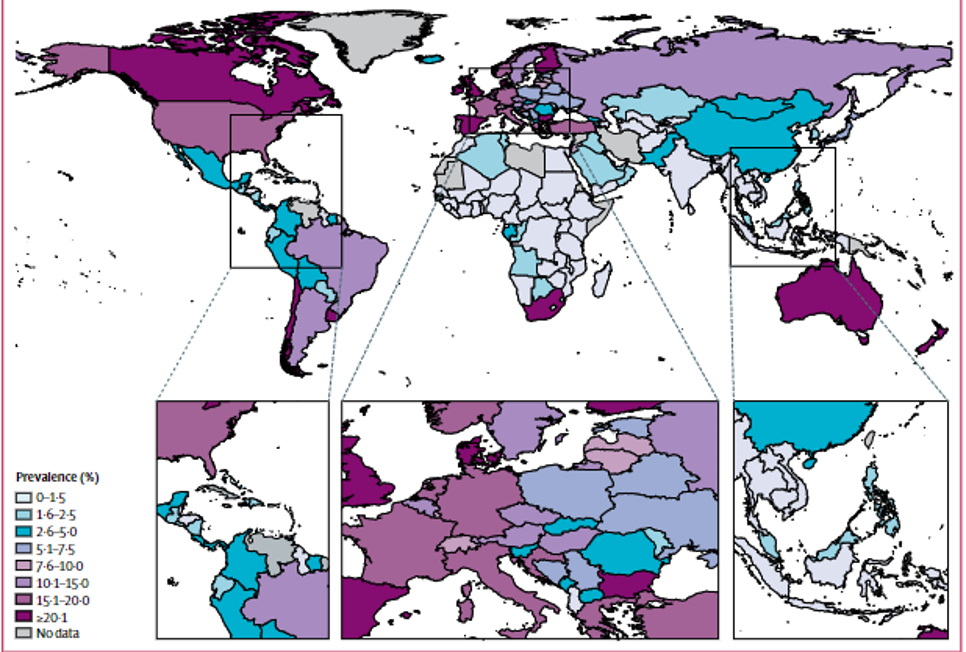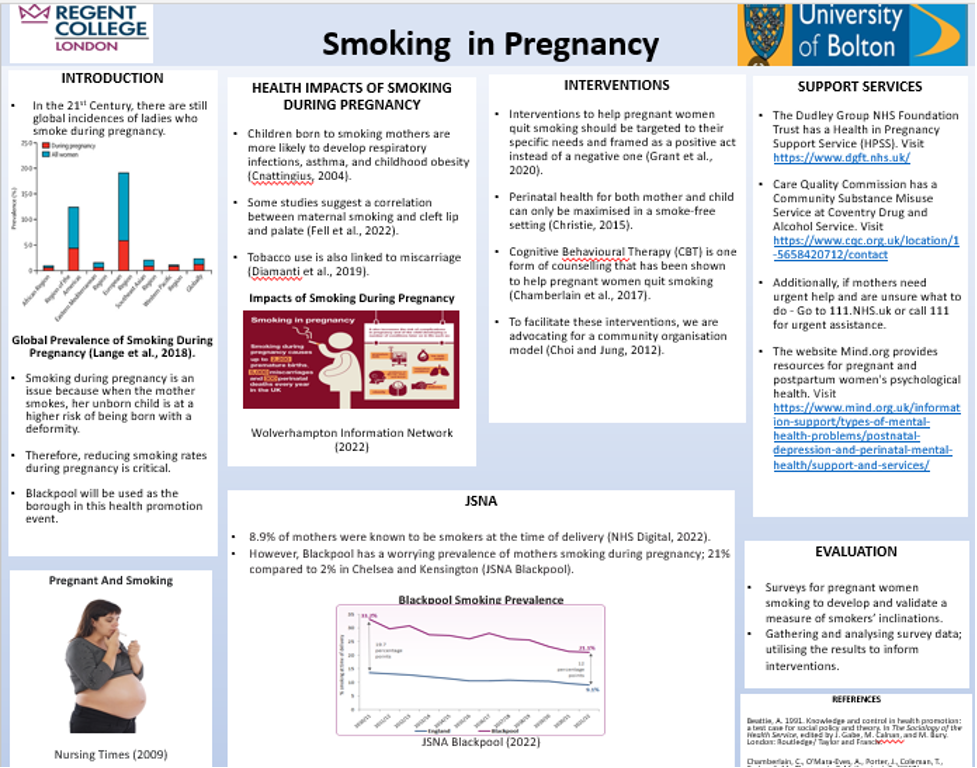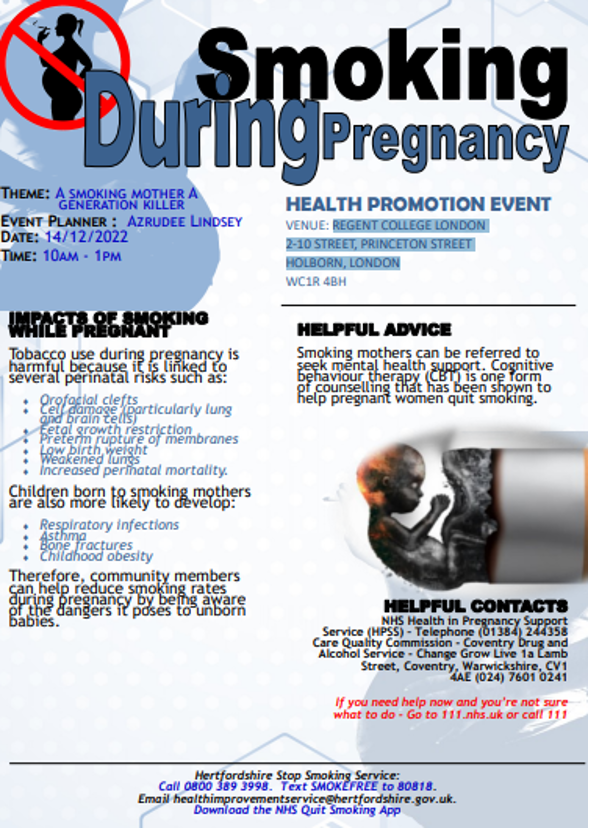Introduction
The purpose of this paper is to assess a health promotion event that was planned as an intervention for smoking in pregnant women and conducted at the University of Bolton. Health promotion is the technique of encouraging people at all levels of society to take responsibility for their own health and wellness by providing them with the information, resources, and encouragement they need to make positive changes that will have a positive impact on their well-being (Silva et al., 2019). There are numerous approaches to health promotion, most of which are driven by public policy and health promotion theory (Kumar and Preetha, 2012). Smoking in pregnancy is a big health hazard. Nicotine use during pregnancy increases the likelihood of undesirable birth outcomes. Some pregnant women keep smoking despite the recognized risks (Ioakeimidis et al., 2019). With this tendency in mind, it’s important to constantly reach out to pregnant women who smoke with health promotion information. This paper will provide a detailed appraisal of health promotion theories and public policy as they pertain to foetal tobacco exposure. The paper will assess the effectiveness of a health promotion event in reducing prenatal smoking and boosting understanding of the dangers of smoking throughout pregnancy. In particular, it will describe the models and approaches to health promotion that were utilized in the event’s planning, and it will reflect on how the best possible use of the event’s outcomes might be implemented to reduce the prevalence of smoking among pregnant women.
Justification
There are still cases of women smoking while pregnant in the 21st century. In 2018, it was estimated that around 52% of women worldwide smoked daily before becoming pregnant, and about half of those women continued to do so throughout their whole pregnancies (Lange et al., 2018). Findings reveal that pregnancy-related smoking is still widespread in many nations, as illustrated in Appendix A, despite social norms discouraging it. Smoking rates among pregnant women women in the United Kingdom range from 2% in Chelsea and Kensington to 20% in Blackpool, demonstrating the importance of targeting at-risk populations and underserved communities in order to promote health for all pregnant women (JSNA Blackpool, 2022). Since 2010, Blackpool’s Smoking at Time of Delivery rate has been higher than anywhere else in Uk by nearly twice national average (JSNA Blackpool, 2022). Smoking while pregnant is a severe health problem as it has been related to several detrimental health repercussions for both the mother and the growing foetus. Smoking tobacco during gestation is connected with a variety of pregnancy issues such as stillbirth, foetal mortality, ectopic pregnancy, and placental abruption (Lange et al., 2018). The causal relationship between smoking while pregnant and adverse pregnancy outcomes such premature delivery and low birth weight is well documented (Lange et al., 2018). Evidence also links maternal smoking to significant birth defects like mouth clefts, gastroschisis, craniosynostosis, and later-life cognitive dysfunction (Lange et al., 2018).
In England, numerous public programs have been implemented to reduce the prevalence of smoking among pregnant women. First, “Towards a smoke-free generation,” England’s tobacco monitoring process, aims to reduce smoking among pregnant women to 6% through a combination of effective governance (legislation and mandatory services) and targeted, community action, aimed at helping smokers, especially those from marginalized communities, to finally stop smoking (JSNA Blackpool, 2022). Second, the NICE guidance [PH26] aids in prenatal smoking cessation by stressing the importance of referring all smoking pregnant women to services that can assist them in giving up the habit (JSNA Blackpool, 2022). Third, Tobacco Free Lancashire is an alliance of groups working together to make the county of Lancashire smoke-free (JSNA Blackpool, 2022). They have set priorities based on in-depth knowledge of the area’s needs in order to lessen health inequities and boost residents’ life quality. by decreasing the number of people who smoke, particularly pregnant women. The requirements of low-income women smokers are addressed by these regional and national measures.
Needs Assessment
The health promotion event took place at Regent College London. It targeted pregnant women who smoke. It was presented to the wider population to help create awareness of the health risk of smoking during pregnancy. Since the concept of “need” in health care is fluid and open to interpretation, it is not strange that the term “needs assessment” is used in very diverse ways by various specialties (Jordan and Wright, 1997). First, studies have clearly identified that smoking during pregnancy is detrimental to the mother’s and unborn child’s health (Lange et al., 2018). Therefore, according to Bradshaw’s taxonomy of needs, the normative need of pregnant women who smoke would be to fulfil their physiological needs (Asadi-Lari, Packham and Gray, ). This means that pregnant women who smoke have a basic need for proper nutrition, hydration, and a healthy environment in order to support the growth and development of their unborn child. The felt needs of a pregnant woman be to fulfil safety and support needs. For example, a pregnant woman who smokes may feel a strong need to quit smoking to safeguard the health and well-being of her unborn child. She may also feel a need for social support and connection with others in order to navigate the challenges of pregnancy and motherhood. However, the felt need of pregnant women who smoke may be influenced by a variety of factors, including their personal values, beliefs, and circumstances. A pregnant woman who smokes may feel a strong need to continue smoking due to addiction or other personal factors, even if she is aware of the risks to her own and her unborn child’s health.
The expressed needs of pregnant women who smoke may include a need for resources and support to quit smoking, a need for social support and connection with others, and a need for knowledge and awareness about the hazards of smoking while pregnant and the advantages of cessation.
Pregnant women who smoke may express a need for resources such as nicotine replacement therapy, medications, counselling, and support groups to help them quit smoking (Lange et al., 2018). They may also express a need for social support and connection with others, including family, friends, and healthcare providers, in order to navigate the challenges of pregnancy and motherhood. Variations in prenatal smoking rates among British cities are revealed by the JSNA. Pregnancy-related cigarette use varies greatly across the country, from 2% in Chelsea and Kensington to 20% in Blackpool (JSNA Blackpool, 2022). These variances are linked to patterns of socioeconomic deprivation. The data show that smoking rates are higher among pregnant women who are living in poverty, or who have lower levels of education (JSNA Blackpool, 2022). Other needs that may be identified through JSNA data include disparities in access to healthcare, support from social networks, and the unavailability of tobacco cessation resources in the local area.
Planning and Design of the Event
The health promotion activity required careful planning and design to ensure that it would be effective in meeting the needs of the intended audience. The objectives of this health promotion event include: 1) To increase awareness of the risks of smoking during pregnancy, 2) To provide information and resources to help expectant women quit smoking, and 3) To improve the health of mothers-to-be and their families by decreasing the rates of expectant women who smoke.
To achieve the aforementioned objectives, the HP poster is planned using Beattie’s model of health promotion. This model based on the idea that health promotion interventions should be based on a clear understanding of the factors that influence health behaviors and should be designed to address these factors in a comprehensive and integrated way (Beattie, 1991). In the context of smoking during pregnancy, the Beattie model suggests that effective health promotion interventions should aim to address the social, economic, cultural, and psychological factors that contribute to women smoking during pregnancy. One such approach is to educate expecting mothers about the dangers of smoking, as well as support and resources to help them quit. It may also involve addressing underlying social and economic conditions that contribute to smoking, such as poverty and lack of access to healthcare.
The HP poster utilizes an educational health promotion approach (). Educating the public more broadly about the dangers of smoking during pregnancy is expected to encourage pregnant women to stop smoking. The poster and leaflet (Appendix ) provide knowledge to expectant mothers about the consequences of smoking, aiding them to explore their own core beliefs and to discover how to give up smoking. The community at large will also have an understanding of the effects of smoking during pregnancy and support systems to help smoking cessation in pregnant women.
The health promotion event also utilized a behaviour change approach (), that is, targeting behaviour change from smoking to not smoking. However, according to Grant et al. (2020), women from disadvantaged communities may face additional obstacles while attempting to quit smoking (Grant et al., 2020). This is because society stigmatizes pregnant women who smoke, which makes it difficult for women to get help out of fear. Therefore, the intervention sought to help pregnant women quit smoking by being framed as a positive action instead of a negative one and targeted to their specific needs.
Conclusion
The purpose of this paper is to assess a health promotion event delivered at the University of Bolton with the intention of intervening against smoking amongst pregnant women. Findings reveal that smoking continues to be common among pregnant women in many nations, despite social norms discouraging it. Pregnancy-related smoking is a major public health concern because of the many negative effects it has on both the woman and her developing child, including but not limited to respiratory infections, childhood obesity, and even miscarriage. By increasing the risk of complications during pregnancy, smoking affects the ability of pregnant mothers to fulfill the physiological and safety needs for their unborn children. Using a health promotion strategy based on education, the event promotes a better lifestyle by informing participants about the dangers of smoking during pregnancy. By aiming to cut down on smoking during pregnancy, the health of mothers and their children will improve.
There are a number of areas where further research on smoking during pregnancy could be beneficial. Despite the many risks associated with smoking during pregnancy, many women struggle to quit. Future research could focus on developing and testing new interventions to help pregnant women quit smoking, such as tailored quit-smoking programs or the use of novel nicotine replacement therapies. Future research could also focus on identifying the social, economic, cultural, and psychological factors that contribute to smoking during pregnancy in order to develop more targeted and effective interventions.
References
Ioakeimidis, N., Vlachopoulos, C., Katsi, V. and Tousoulis, D. (2019). Smoking cessation strategies in pregnancy: Current concepts and controversies. Hellenic Journal of Cardiology, 60(1), pp. 11-15.
Beattie, A. (1991). Knowledge and control in health promotion: a test case for social policy and theory. In The Sociology of the Health Service, edited by J. Gabe, M. Calnan, and M. Bury. London: Routledge/ Taylor and Francis.
Kumar, S., and Preetha, G. S. (2012). Health promotion: an effective tool for global health. Indian journal of community medicine: official publication of Indian Association of Preventive & Social Medicine, 37(1).
Silva, C.R.D.T., Carvalho, K.M.D., Figueiredo, M.D.L.F., Silva-Júnior, F.L., Andrade, E.M.L.R. and Nogueira, L.T. (2019). Health promotion of frail elderly individuals and at risk of frailty. Revista Brasileira de Enfermagem, 72, pp. 319-327.
Lange, S., Probst, C., Rehm, J. and Popova, S. (2018). ‘National, regional, and global prevalence of smoking during pregnancy in the general population: a systematic review and meta-analysis.’ The Lancet Global Health, 6(7), pp. e769-e776.
JSNA Blackpool. (2022). Smoking In Pregnancy. [online] Available at: https://www.blackpooljsna.org.uk/Starting-Well/Maternity/Smoking-in-Pregnancy.aspx#:~:text=Statistics%20on%20Women’s%20Smoking%20Status,This%20compares%20to%209.1%25%20nationally. [Accessed: 23 November 2022]
Jordan, J. and Wright, J. (1997). Making sense of health needs assessment. The British Journal of General Practice, 47(424), p.695.
Grant, A., Morgan, M., Gallagher, D., and Mannay, D. (2020). Smoking during pregnancy, stigma and secrets: Visual methods exploration in the UK. Women and Birth, 33(1), pp.70-76
Appendices
Appendix A

Appendix B

Appendix C
Health Promotion Questionnaire
Smoking During Pregnancy In the UK
1. Before this health promotion event, did you know or hear about the effects smoking had on pregnant women? __________
2. If so, list the effects of smoking during pregnancy you were aware of or heard about.
________________________________________________________________________________________________________________________________________________________________________________________________________________________________________________________________________________________________________________________________________________________________________________________________________________________________________________________________
3. Are you aware of the health support services for pregnant women available in your neighbourhood? __________
4. From the leaflet, do you feel more educated about the implications of smoking during pregnancy? __________
5. Will you pass this information onto your family/friends? __________
6. Which strategies do you feel would work better toward creating awareness of the harmful effects of smoking during pregnancy?
________________________________________________________________________________________________________________________________________________________________________________________________________________________________________________________________________________________________________________________________________________________________________________________________________________________________________________________________________________________________________________________________________________________________________________________________
7. After reading the leaflet, what recommendations would you make to a friend or any individual that could help improve her well-being?
________________________________________________________________________________________________________________________________________________________________________________________________________________________________________________________________________________________________________________________________________________________________________________________________________________________________________________________________________________________________________________________________________________________________________________________________
8. Was the health promotion event on smoking during pregnancy impactful? ___________ If no, state a reason for your answer.
________________________________________________________________________________________________________________________________________________________________________________________________________________________________________________________________________________________________________________________________________________________________________________________________________________________________________________________________
9. How satisfied are you with this leaflet?
- Very satisfied
- Somehow satisfied
- Not satisfied at all
10. Are there any suggestions you would like to make?
________________________________________________________________________________________________________________________________________________________________________________________________________________________________________________________________________________________________________________________________________________________________________________________________________________________________________________________________
Appendix D

 write
write